Answered step by step
Verified Expert Solution
Question
1 Approved Answer
Calculation Procedure for Construction (Fixed Cost) The program that you create will perform a complete Breakeven Analysis for a single construction option. Your team
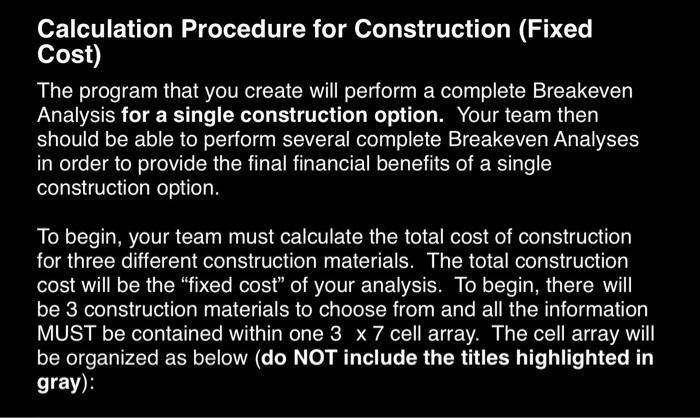
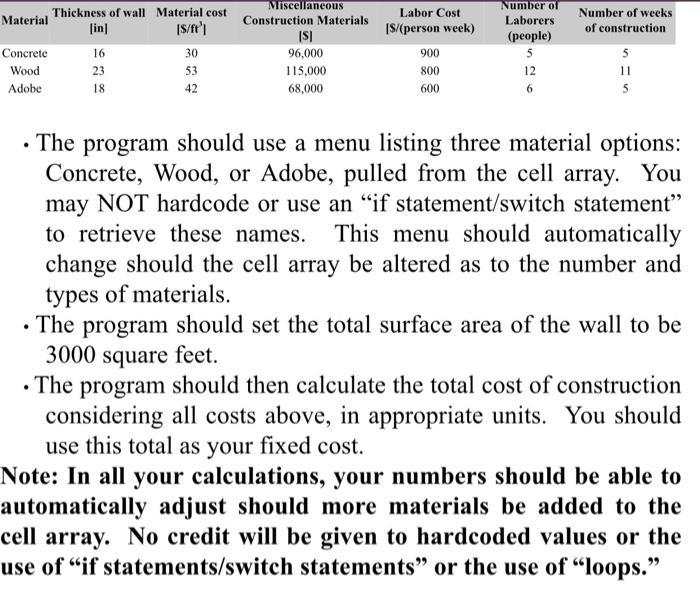
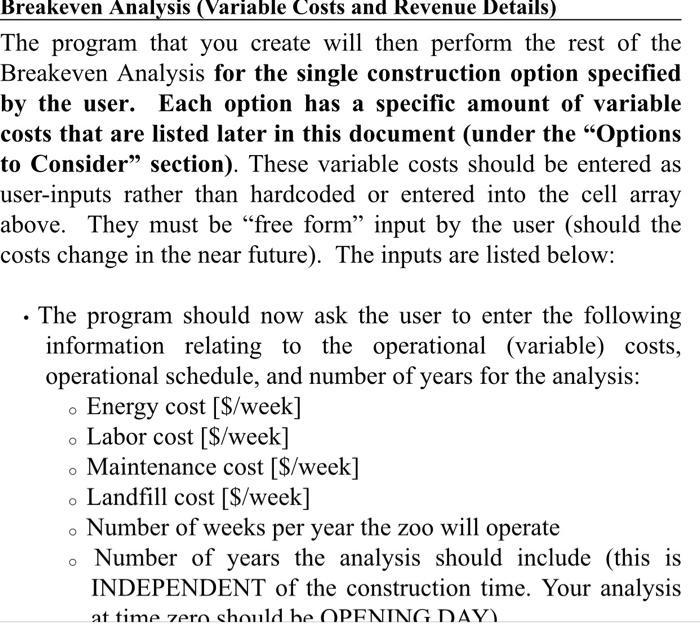

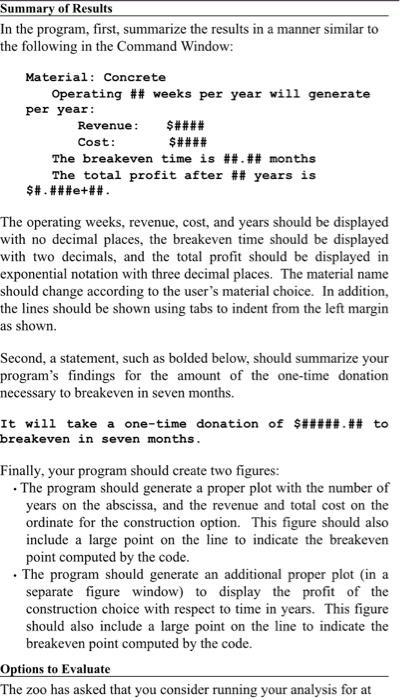
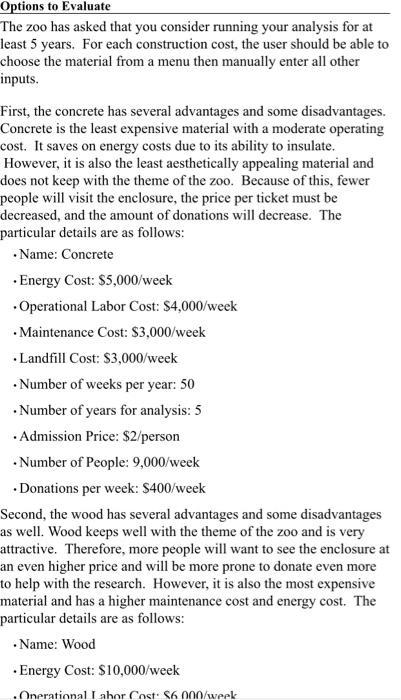
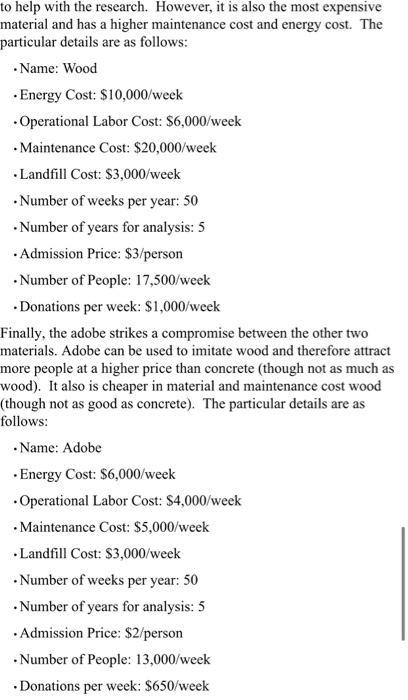
Calculation Procedure for Construction (Fixed Cost) The program that you create will perform a complete Breakeven Analysis for a single construction option. Your team then should be able to perform several complete Breakeven Analyses in order to provide the final financial benefits of a single construction option. To begin, your team must calculate the total cost of construction for three different construction materials. The total construction cost will be the "fixed cost" of your analysis. To begin, there will be 3 construction materials to choose from and all the information MUST be contained within one 3 x 7 cell array. The cell array will be organized as below (do NOT include the titles highlighted in gray): Material Concrete Wood Adobe Thickness of wall Material cost [in] [S/ft'] 16 23 18 30 53 42 Miscellaneous Construction Materials [S] 96,000 115,000 68,000 Labor Cost [S/(person week) 900 800 600 Number of Laborers (people) 5 12 6 Number of weeks of construction 5 11 5 . The program should use a menu listing three material options: Concrete, Wood, or Adobe, pulled from the cell array. You may NOT hardcode or use an "if statement/switch statement" to retrieve these names. This menu should automatically change should the cell array be altered as to the number and types of materials. . The program should set the total surface area of the wall to be 3000 square feet. The program should then calculate the total cost of construction considering all costs above, in appropriate units. You should use this total as your fixed cost. Note: In all your calculations, your numbers should be able to automatically adjust should more materials be added to the cell array. No credit will be given to hardcoded values or the use of "if statements/switch statements" or the use of "loops." Breakeven Analysis (Variable Costs and Revenue Details) The program that you create will then perform the rest of the Breakeven Analysis for the single construction option specified by the user. Each option has a specific amount of variable costs that are listed later in this document (under the "Options to Consider" section). These variable costs should be entered as user-inputs rather than hardcoded or entered into the cell array above. They must be "free form" input by the user (should the costs change in the near future). The inputs are listed below: The program should now ask the user to enter the following information relating to the operational (variable) costs, operational schedule, and number of years for the analysis: Energy cost [$/week] Labor cost [$/week] Maintenance cost [$/week] Landfill cost [$/week] . Number of weeks per year the zoo will operate o Number of years the analysis should include (this is INDEPENDENT of the construction time. Your analysis at time zero should be OPENING DAY) . The program should finally ask the user to enter the zoo's anticipated public interest and donations, which will be used to calculate revenue: Price of admission per person [S/person] Number of people per week that will visit the zoo . Expected donations per week [$/week] Breakeven Analysis (Process) The program should conduct a breakeven analysis using these steps: . Determine the total fixed costs to construct the enclosure considering material costs, miscellaneous costs, and labor costs Determine the total variable cost of operating the enclosure per week. . Determine the total cost to operate the selected construction option for the number of years requested by the user (the time does NOT include construction time). The total cost vector should be calculated for the number of years requested, where each column is a year. . Determine the total revenue for the number of years requested by the user. The total revenue vector should be calculated for the number of years requested, where each column is a year. The calculation should include the donations Determine the total profit for the number of years requested by the user. The total profit vector should be calculated for the number of years requested, where each column is a year. The program should now determine the breakeven point in months. This should be accomplished by creating a mathematical formula to express the breakeven point as a function of cost. The program should also, at the request of the zoo, determine how much of a one-time donation it would take to "breakeven" at the end of 7 months. You may assume that none of the given options will break even in less than 6 months. Summary of Results In the program, first, summarize the results in a manner similar to Summary of Results In the program, first, summarize the results in a manner similar to the following in the Command Window: Material: Concrete Operating ## weeks per year will generate per year: Revenue: Cost: #### $#### The breakeven time is # #.## months The total profit after ## years is $#.###e+##. The operating weeks, revenue, cost, and years should be displayed with no decimal places, the breakeven time should be displayed with two decimals, and the total profit should be displayed in exponential notation with three decimal places. The material name should change according to the user's material choice. In addition, the lines should be shown using tabs to indent from the left margin as shown. Second, a statement, such as bolded below, should summarize your program's findings for the amount of the one-time donation necessary to breakeven in seven months. It will take a one-time donation of $#####.## to breakeven in seven months. Finally, your program should create two figures: . The program should generate a proper plot with the number of years on the abscissa, and the revenue and total cost on the ordinate for the construction option. This figure should also include a large point on the line to indicate the breakeven point computed by the code. . The program should generate an additional proper plot (in a separate figure window) to display the profit of the construction choice with respect to time in years. This figure should also include a large point on the line to indicate the breakeven point computed by the code. Options to Evaluate The zoo has asked that you consider running your analysis for at Options to Evaluate The zoo has asked that you consider running your analysis for at least 5 years. For each construction cost, the user should be able to choose the material from a menu then manually enter all other inputs. First, the concrete has several advantages and some disadvantages. Concrete is the least expensive material with a moderate operating cost. It saves on energy costs due to its ability to insulate. However, it is also the least aesthetically appealing material and does not keep with the theme of the zoo. Because of this, fewer people will visit the enclosure, the price per ticket must be decreased, and the amount of donations will decrease. The particular details are as follows: .Name: Concrete Energy Cost: $5,000/week Operational Labor Cost: $4,000/week Maintenance Cost: $3,000/week .Landfill Cost: $3,000/week Number of weeks per year: 50 Number of years for analysis: 5 Admission Price: $2/person Number of People: 9,000/week Donations per week: $400/week Second, the wood has several advantages and some disadvantages as well. Wood keeps well with the theme of the zoo and is very attractive. Therefore, more people will want to see the enclosure at an even higher price and will be more prone to donate even more to help with the research. However, it is also the most expensive material and has a higher maintenance cost and energy cost. The particular details are as follows: Name: Wood Energy Cost: $10,000/week Onerational Labor Cost: $6.000/week to help with the research. However, it is also the most expensive material and has a higher maintenance cost and energy cost. The particular details are as follows: Name: Wood - Energy Cost: $10,000/week Operational Labor Cost: $6,000/week - Maintenance Cost: $20,000/week Landfill Cost: $3,000/week Number of weeks per year: 50 Number of years for analysis: 5 Admission Price: $3/person Number of People: 17,500/week Donations per week: $1,000/week Finally, the adobe strikes a compromise between the other two materials. Adobe can be used to imitate wood and therefore attract more people at a higher price than concrete (though not as much as wood). It also is cheaper in material and maintenance cost wood (though not as good as concrete). The particular details are as follows: .Name: Adobe Energy Cost: $6,000/week Operational Labor Cost: $4,000/week Maintenance Cost: $5,000/week Landfill Cost: $3,000/week -Number of weeks per year: 50 Number of years for analysis: 5 Admission Price: $2/person Number of People: 13,000/week Donations per week: $650/week
Step by Step Solution
★★★★★
3.37 Rating (169 Votes )
There are 3 Steps involved in it
Step: 1
ANSWER clear clc Define constants numMaterials 3 surfaceArea 3000 Create cell array for material information materials Concrete 16 30 96000 900 5 5 Wood 23 53 115000 800 12 11 Adobe 18 42 68000 600 6 ...
Get Instant Access to Expert-Tailored Solutions
See step-by-step solutions with expert insights and AI powered tools for academic success
Step: 2

Step: 3

Ace Your Homework with AI
Get the answers you need in no time with our AI-driven, step-by-step assistance
Get Started


